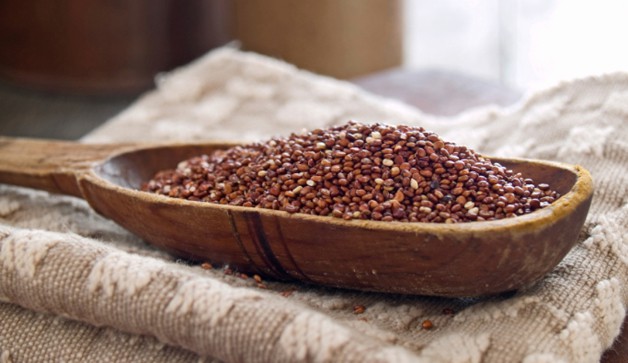With Quinoa rapidly gaining notoriety among health fooders, it’s time we looked at Quinoa’s cousin, a ‘superfood’ grain native to the Andes region of South America.
Coming from the same region as Quinoa (native to Peru & Bolivia), Kaniwa is smaller than it’s cousin, slightly darker, and more sweet.
Sold as a whole grain, Kaniwa is actually a seed from a plant called goosefoot.
Kaniwa has been part of the local diet in the Andes for centuries, but has been recently rediscovered by the rest of the world.
Although Kaniwa hasn’t been studied fully yet, it’s nutritional benefits are already setting Kinawa up to be on par or even better than its popular cousin.
Why Kaniwa
Kaniwa contains 3% more protein than its cousin quinoa, and is also high in natural fiber and amino acids.
Lysine, an essential amino acid for human beings is highly present in Kaniwa, which is normally unusual for grains. It also has a much higher iron content than Quinoa, which is essential for a healthy diet.
Kaniwa is also a natural gluten-free superfood, good news for people looking to go gluten-free, especially because Kaniwa has the same B vitamins and minerals as normal whole-grain wheat.
Percent Daily Values of protein, carbohydrates, and minerals of Kaniwa are extremely high, making it a great choice as a staple in your diet.

Having a negligible crude fat content, Kaniwa is a great and safe choice for people looking for vegan and vegetarian-friendly protein sources. 3.5 ounces of Kaniwa contains 30% of recommended daily fiber intake.
Another great feature of this superfood is that it contains natural antioxidants called flavonoids, particularly isorhamnetin and quercetin, putting it above its cousin Quinoa as a supreme superfood.
Isorhamnetin and quercetin help reduce risk of certain types of inflammatory diseases and help support a healthy heart.
As a vegetable, it contains no saturated fat or chloresterol.
With all of these great features, protein, iron, vitamin B, minerals, fiber, and antioxicants, in a simple and easy to prepare seed, Kaniwa is a great addition to any healthy diet and is easy to prepare!
Cooking With Kaniwa

Along with the nutritional value, Kaniwa doesn’t contain saponins like its cousin Quinoa, which leaves Quinoa with a bitter, somewhat soapy flavor.
Quinoa is tedious to prepare because you have to rinse it extremely thoroughly, Kaniwa is less vexing.
To get the best flavor from Kaniwa, it should be toasted before cooking.
Cook for 2-3 minutes over a dry skillet on medium heat, stirring thoroughly to ensure even roasting.
To cook Kaniwa, use a 1:2 ratio of water to Kaniwa, and simmer for 15-20 minutes like you would white rice.
You can also stew it inside of a crackpot on high for two hours. One cup dry Kaniwa will yield 2 cups on average when cooked.
Kaniwa’s flavor has been described as being nutty, mild and slightly sweet, similar to Quinoa. It doesn’t ‘fluff’ like quinoa, but it also doesn’t congeal like millet will.
When you’ve prepared your Kaniwa, there’s a range of possible ways to incorporate the seed into your recipes.
It cooks quickly, and can be added to stir fry, soup, stews, and salads to thicken your dish.
Kaniwa can easily replace rice as a grain bed cooked in tandem with stir fry vegetables, and it serves as an excellent flavor compliment to fish.
Pair it with tofu for a hearty meal, or heat with milk or soy milk for a delicious breakfast porridge, add a dash of raisins or chopped nuts with some sweetener to create a filling and nutritious start of your day.
Kaniwa will keep for a year when sealed in tupperware or a glass container in the cabinet!
Grinding It Down!
While there’s many tasty and nutritious applications of Kaniwa itself, it can also be ground into a flour!
 While you won’t be able to bake Kaniwa well on its own due to its high protein content, you can use it to replace breadcrumbs to coat fish, chicken, or other main features of a meal.
While you won’t be able to bake Kaniwa well on its own due to its high protein content, you can use it to replace breadcrumbs to coat fish, chicken, or other main features of a meal.
That doesn’t mean that you can’t used Kaniwa in your baking, add Kaniwa-based flour to unbleached flour when cooking to give your baked goods a heartier flavor and nutritional boost.
Start with 1/4 cup of Kaniwa flour added to any recipe, without adjusting liquids called for to add an extra flair to your meal.
The Rise of a Superfood
 As a great singular addition to any healthy cooker, Kaniwa’s easy preparation and extensive benefits make the ‘superfood’ title of Kinawa extremely apt.
As a great singular addition to any healthy cooker, Kaniwa’s easy preparation and extensive benefits make the ‘superfood’ title of Kinawa extremely apt.
Kaniwa has none of the negative attributes of Quinoa and even more positive benefits, and although it’s slightly more rare to find in a grocery store than Quinoa due to its recent appearance in the health food scene, you can easily find it at your local health food store.
Kaniwa won’t replace grain-based flour entirely, but its versatility in its whole seed and flour form means that you’ll be able to find applications for it all over the kitchen.
Check your local health food store and give Kaniwa a try!





Dear R.P.,
I Have been on the path to heal my body and mind in healthful ways. My parents generation believe more in Doctors and conventional medicine.
My question to you is , are there any healthful, holistic alternatives for a woman of 71 who had Kidney failure and needs to be on dialysis three times a week. (Family Member)
I have heard that suggestions that there may be alternative medicine.
I look forward
To your reply